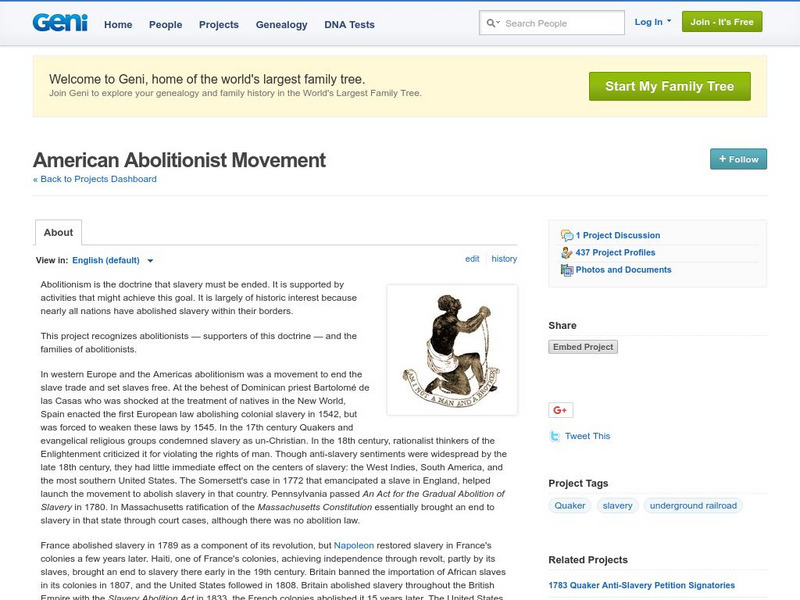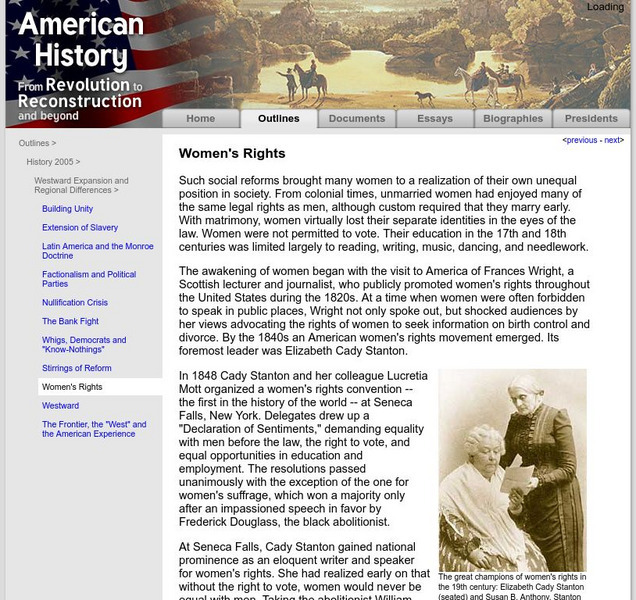University of Groningen
American History: Outlines: Westward Expansion
This article offers a detailed history of early 19th century westward migration and the social diversity of the pioneers moving west.
Louisiana Department of Education
Louisiana Doe: Louisiana Believes: Social Studies: Grade 4: Westward Expansion
This instructional task asks students to analyze the impact Westward Expansion had on the people and cultures of the American West.
Other
Geni: American Abolitionist Movement
Looks at the history of the abolitionist movement in the United States, the key people involved, and important events.
Other
Iowa Culture: American Indians and Westward Expansion
Learn the factors, forces or reasons people moved from one geographic area to another in early America.
PBS
Wnet: Thirteen: Freedom: A History of Us: Liberty for All? Webisode 3
Webisode 3 - Liberty for All? The history of the United States is presented in a series of webisodes, within each are a number of segments.Included are links to lesson plans, teacher guides, resources, activities, and tools.
Utah Education Network
Uen: Blast Through the Past: Transportation & Movement in Utah [Pdf]
Fourth graders will discuss the different types of transportation prior to the transcontinental railroad. They will also write an essay using the information discussed to present the pros and cons of transporting eggs to big cities by...
University of Groningen
American History: Outlines: Movement South and Westward
Following Eli Whitney's invention in 1793 of the cotton gin -- a machine that separated raw cotton from seeds and other waste -- the cotton market boomed. Planters in the South bought land from small farmers who frequently moved farther...
Library of Congress
Loc: Teachers: Journeys West
A series of lessons utilizing primary texts, including narratives, photographs, and maps, through which students explore the following question: "What motivated thousands of people to journey west during the 1800s?"
Stanford University
Sheg: Document Based History: Reading Like a Historian: Manifest Destiny
[Free Registration/Login Required] Students use primary source documents to investigate central historical questions. In this investigation students use nineteenth-century maps and art, and consider the roots of American exceptionalism.
Alabama Learning Exchange
Alex: Spice Up the Nineteenth Century!
Students will make interactive outlines using the Internet of the reform movements, literature, trails, religion or technology of the early nineteenth century.
Ohio History Central
Ohio History Central: Tecumseh's Confederation
This page describes Tecumseh's work toward an Indian confederacy that would be able to survive against the westward movement of whites.
University of Groningen
American History: Outlines: Stirrings of Reform
The democratic upheaval in politics exemplified by Jackson's election was merely one phase of the long American quest for greater rights and opportunities for all citizens. Another was the beginning of labor organization, primarily among...
University of Groningen
American History: Outlines: Women's Rights
Such social reforms brought many women to a realization of their own unequal position in society. From colonial times, unmarried women had enjoyed many of the same legal rights as men, although custom required that they marry early. With...
University of Groningen
American History: Outlines: Latin America and the Monroe Doctrine
Outline of the Latin America independence movement and the accompanying spirit of U.S. support as expressed through the Monroe Doctrine.














